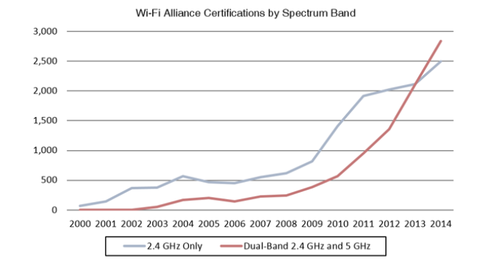5 GHz Is Finally Mainstream
The Wi-Fi Alliance's new report shows widespread use of the 5 GHz spectrum by WiFi devices, but it shouldn't have taken this long. The alliance could have done more to speed 5 GHz adoption.
May 4, 2015

According to a new report by the Wi-Fi Alliance and ABI Research, wireless networking in the 5 GHz spectrum has been adopted widely enough to now be considered mainstream. The report indicates that 68% of client devices shipping this year will use 5 GHz, and by 2019 that number will climb to over 96%.
To those of us in the business of WiFi, the migration of devices away from the channel-constrained and crowded 2.4 GHz band is a good thing. Today’s enterprise WiFi is about small cells, high-device counts, and going to 5 GHz where the channels are more abundant by an order of magnitude.
While the WiFi Alliance's proclamation is welcome by wireless network administrators, a case also can be made that the alliance -- a consortium of wireless device makers -- should have done more through the years to get us to this 5 GHz saturation point faster.
The rapid adoption of 802.11ac is certainly the backdrop for the report published by ABI Research. But 5 GHz has been available since 1999, with the ratification of the 802.11a standard. For the last decade, WLAN access points have typically been dual-band 802.11a/g, or dual-band 802.11n. The 5 GHz infrastructure has been ready for a long time, but client devices have been far slower to catch on, as reflected in the report see bar chart below). And here’s where I find some degree of fault with the Wi-Fi Alliance.
Figure 1: 
In its early years, the alliance did a spectacular job of both promoting the fledgling WLAN technology, as well as promoting the notion of certified interoperability based on a reasonable set of technical criteria to an industry that seriously needed it. The alliance’s place in 802.11’s successful history is undeniable, but it’s not all positive, as the industry group arguably lost its WLAN leadership role as it became a victim to its membership.
We may be at spectacular juncture where 5 GHz has achieved dominance, but never have client devices been more feature-fragmented. The manufacturers that are members in the alliance have brought us to a contentious place where there are crazy gaps in what different devices can do for supported data rates and security capabilities (just two examples), yet they all end up Wi-Fi Certified. It’s fair to ask: Given that 2.4 GHz has always been considered a “junk band,” why weren’t alliance members releasing dual-band clients for the last several years?
The infographic released with the ABI/Wi-Fi Alliance report (see below) describes millions and billions of dual-band, 5 GHz-capable devices. The sheer volume of WiFi clients in use around the globe is amazing, and at the same time, other non-WiFi wireless devices also are on the rise. The 2.4 GHz band remains extremely popular for all matter of gadgetry, so the march to 5 GHz WiFi will help keep the evolution of WLAN strong for the foreseeable future.
Despite the alliance's proclamation that 5 GHz has officially “arrived”, one company is still trying to milk the waning value of the overused 2.4 GHz band. Satellite company GlobalStar may actually convince the FCC that somehow its overhyped 2.4 GHz TLPS technology will benefit a WLAN industry whose future clearly lies in 5 GHz.
We should all be past this foolishness by now, and the Wi-Fi Alliance also partially owns the TLPS “problem” that the rest of the industry is rallying against by not doing more to advance 5 GHz earlier.
Figure 2: .jpg?width=700&auto=webp&quality=80&disable=upscale)
You May Also Like



